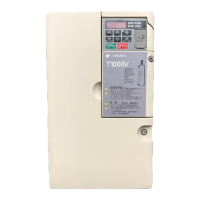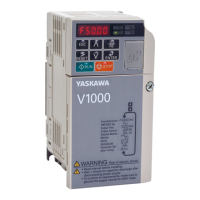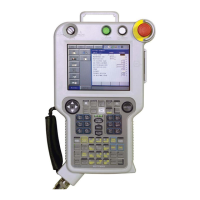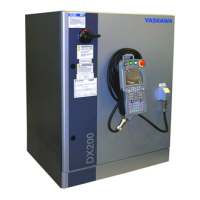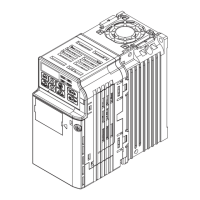1.2 General Description
26 YASKAWA ELECTRIC SIEP C710616 30B YASKAWA AC Drive T1000A Technical Manual
u Control Mode Selection
Table 1.2 gives an overview of the T1000A control modes and their various features.
Table 1.2 Control Modes and their Features
Motor Type
Induction Motors,
Induction Synchronous
Motors
Induction Motors Permanent Magnet Motors Comments
Control Mode V/f V/f w/PG OLV CLV OLV/PM AOLV/PM CLV/PM –
Parameter Setting A1-02 = 0 A1-02 = 1 A1-02 = 2 A1-02 = 3 A1-02 = 5 A1-02 = 6 A1-02 = 7
Default Setting is Open Loop Vector
Control.
Basic Description
V/f control
V/f control
using motor
speed
feedback
Open Loop
Vector control
Closed Loop
Vector control
Open Loop
Vector control
for PM motors
Open Loop
Vector control
for IPM
motors
Closed Loop
Vect or control
for PM motors
–
Type of
Applications
Motor Type IM IM IM IM PM IPM PM –
Multi Motor YES N/A N/A N/A N/A N/A N/A –
Motor data
unknown
YES N/A N/A N/A N/A N/A N/A –
High Speed
Accuracy
N/A YES YES YES YES YES YES –
High Speed
Response
N/A N/A YES YES N/A YES YES –
Zero Speed
Control
N/A N/A N/A YES N/A YES YES –
Torque Control
Operation
N/A N/A N/A YES N/A YES YES –
Torque Limit
Operation
N/A N/A YES YES N/A N/A YES –
PG Option Card N/A
PG-B3 or PG-
X3
N/A
PG-B3 or PG-
X3
N/A N/A PG-X3 –
Control
Characteristics
Speed Control
Range
1:40 1:40 1:200 1:1500 1:20 1:100 1:1500
May fluctuate with characteristics and
motor temperature.
Speed Accuracy ±2 to 3% ±0.03% ±0.2% ±0.02% ±0.2% ±0.2% ±0.02%
Speed deviation when operating at
constant speed. May fluctuate with
characteristics and motor temperature.
Speed Response
3 Hz
(approx.)
3 Hz
(approx.)
10 Hz 50 Hz 10 Hz 10 Hz 50 Hz
Max. frequency of a speed reference signal
that the drive can follow. May fluctuate
with characteristics and motor temperature.
Starting Torque 150% at 3 Hz 150% at 3 Hz
200% at 0.3
Hz
200% at 0
r/min
100% at 5%
speed
200% at
0 r/min
200% at
0 r/min
May fluctuate with characteristics and
motor temperature.
Performance may differ by capacity.
Application-
Specific
Auto-Tuning
• Energy
Saving
Tuning
• Termination
resistor
• Energy
Saving
Tuning
• Termination
resistor
• Rotational
• Stationary
• Termination
resistor
• Rotational
• Stationary
• Termination
resistor
•ASR
• Inertia
• Stationary
• Termination
resistor
• Stationary
• Termination
resistor
• Stationary
• Termination
resistor
•ASR
• Inertia
• Encoder
Offset
Automatically adjusts parameter settings
that concern electrical characteristics of the
motor.
Torque Limit N/A N/A YES YES N/A YES YES
Sets the maximum torque for the motor to
protect the load and connected machinery.
Torque Control N/A N/A N/A YES N/A N/A YES
Allows direct control of motor torque for
tension control and other such applications.
Zero Servo
Control
N/A N/A N/A YES N/A N/A YES Locks the rotor position.
Speed Search YES YES YES – YES YES YES
Bi-directional speed detection of a coasting
motor to restart it without stopping.
Energy-Saving
Control
YES YES YES YES N/A
YES (IPM
motors only)
YES (IPM
motors only)
Saves energy by always operating the
motor at its maximum efficiency.
Feed Forward
Control
N/A N/A N/A YES N/A N/A YES
Improves speed accuracy when the load
changes by compensating effects of the
system inertia.
Kinetic Energy
Buffering
YES YES YES YES YES YES YES
Decelerates the drive to allow it to ride
through a momentary power loss and
continue operation.
Overexcitation
Deceleration
YES YES YES YES N/A N/A N/A
Provides fast deceleration without using a
braking resistor.
Inertia Tuning,
ASR Tuning
N/A N/A N/A YES N/A N/A YES
Provides automatic Speed Control and
Feed Forward function tuning.
Overvoltage
Suppression
YES YES YES YES YES YES YES
Prevents overvoltage by reducing
regenerative torque in application where
constant speed is not required.
Note: The drive cannot reduce
regenerative torque when using the V/f
Control mode. Instead try increasing the
frequency level to avoid overvoltage in V/f
Control.
High Frequency
Injection
N/A N/A N/A N/A N/A
YES (IPM
motors only)
N/A
Greatly increases the speed control range
of an IPM motor.
Disturb
Function
YES N/A N/A N/A N/A N/A N/A
The Disturb Function changes the
frequency reference in periodic intervals.

